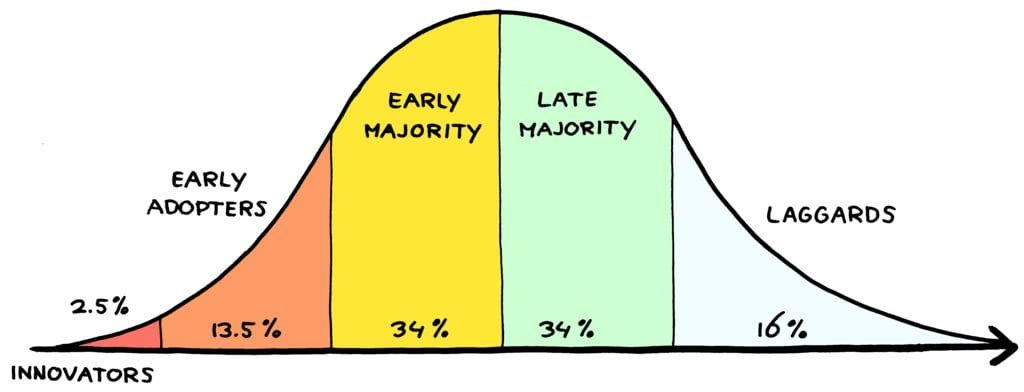The Law of Diffusion of Innovation: Part 1
What is the law of diffusion of innovation? For starters, it is a theory developed in 1962 by E.M. Rogers and is known to be one of the oldest social science theories. This theory explains how, over time, a product spreads and how quickly a specific population or social system adopts it. Ultimately, people adopt the product or idea at the start of the diffusion, one way or another, and at various times.
So, how does this concept relate to marketing? This concept interacts with the market differently, explicitly targeting each group and selling a product influencing all groups. Creating a product meant to influence each group in the chasm requires marketing teams to build long-term strategies with the end goal of all groups finally adopting this product being presented to them.
What are the Different Parts of the Chasm?
Think of the chasm as a standard distribution curve you learned in your high school statistics class.
Innovators
The starting point of the curve is referred to as the innovators. They make up only 2.5% of the population, and they are the ones who want to be the first to try the innovation at hand.
Personality:
They are willing to take risks and often develop new ideas.
Little to no strategizing regarding a marketing team is needed to convince this small portion of the population.
Early Adopters
The next part of the curve is the early adopters, who comprise 13.5% of the population.
Personality:
Opinion leaders.
Known to take on leadership roles and welcome change with open arms.
Understand that change is good and are very comfortable adopting new ideas.
Strategizing here should include how-to manuals or information sheets about implementing the innovation. Only a little information is needed for them to flip the switch.
Early Majority
After the early adopters come the early majority, which takes up 34% of the population; they share this percentage with another group that comes right after them.
Personality:
Unlike the early adopters, the early majority are rarely leaders but still adopt new ideas before the average person.
However, to embrace new ideas, they require evidence that explicitly shows if the innovation works before they are willing to adopt it.
Marketing teams can influence this portion of the population through different strategies, success stories, or just plain evidence of the innovation's success.
Late Majority
The early majority also has a late majority that takes up another 34% of the population.
Personality:
People in this group are skeptics of change and will only take on innovation after the majority has attempted it.
Some strategies marketing teams should attempt to appeal to this group should include information on how many people have tried this innovation and the success rate of adoption.
Laggards
Lastly, the curve's tail consists of the last 16% of the population, the laggards.
Personality:
People who resist change are restricted by tradition and are not known to step out of their box.
Like the late majority, they are skeptical of change and are known to be one of the most challenging groups to adapt to innovation.
Marketing teams should utilize strategies to appeal to this group, including statistics, pressure from people in the earlier groups, and fear appeals.
Do These Groups Interact With One Another?
Even though different groups comprise the chasm, they all work together in one way or another, such as the innovators influencing the early adopters to influence the early majority. We see many of these groups daily, such as social media influencers! In the upcoming blog, I’ll expand on how each group works together and how this affects the marketing world.


